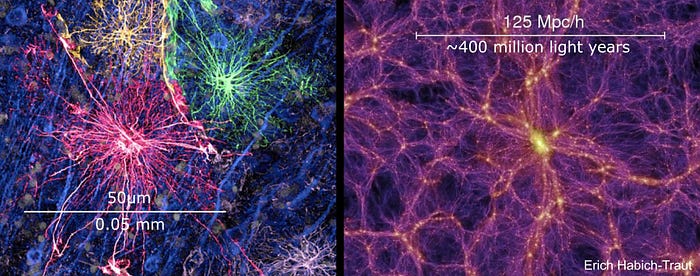The immense processing speed of the human brain can in part or wholly be explained by superluminal signal transmission.

Introduction
Have you ever wondered about the astonishing processing speed of the human brain? One intriguing possibility is that this incredible capability can be partly attributed to superluminal signal transmission.
Enter the WETCOW (Weakly-Evanescent Cortical Wave) model, a groundbreaking concept explored by Vitaly L. Galinsky and Lawrence R. Frank in their March 2023 article published in Nature. They assert that “the effectiveness, robustness, and flexibility of memory and learning constitute the very essence of human natural intelligence, cognition, and consciousness.”
Yet, current perspectives on these profound topics often lack a solid physical theory that explains how the brain communicates internally via its electrical signals. This poses a significant gap in our understanding of human cognition.
In their research, Galinsky and Frank highlight that evanescent waves in the brain—previously dismissed as mere “noise”—are actually vital for human learning and memory. Here’s the kicker: these evanescent waves may travel faster than light. It’s a tantalizing conjecture: evanescent wave → faster than light. This assertion raises essential questions about the nature of consciousness: What is it? Where does it originate? How does it connect to our physical bodies?
Is This True?

In the early 2000s, the scientific community was buzzing with speculation. Some quantum physicists were undecided or opposed to the notion that QUANTUM TUNNELED EVANESCENT WAVES move faster than light.
Their reluctance stems from the apparent violation of Einstein’s theory of relativity: nothing can move faster than light.
However, that is not quite true. The law states that nothing with MASS can move faster than light in a vacuum.
“It’s also said that quantum tunneling can allow particles to pass through barriers at speeds greater than light. But this doesn’t violate special relativity because no information can be transmitted. This phenomenon is a consequence of wave-like behavior in quantum mechanics and doesn’t involve moving information or matter faster than light.“
Hold it right there. Just because that sentence is repeated often doesn’t make it true.
So, what’s going on here?
To understand the claims, we need to look at the SCIENTIFIC METHOD.
In science, the process starts with a hypothesis. You make an educated guess about how something works. Next, you design a practical experiment to test that hypothesis.
The validity of the hypothesis rests on the experiment’s outcome. If the results support the hypothesis, it gains credibility. But there’s more. The experiment must be repeatable. Other scientists should achieve the same results under the same conditions. This repeatability solidifies the hypothesis’s place in the scientific community.
Through this method, science builds knowledge—one hypothesis at a time.
Consider this practical example: music is a type of information. Dr. Nimtz claims he transmitted music through a quantum tunnel at faster-than-light speed. In this practical experiment, which has been repeated many times, you can hear Mozart accelerated to 4.7 times the speed of light.
This Is Classical Music Transmitted In A Non-Classical Way
So, what’s really going on here?
Some elements of human consciousness are moving at speeds that defy our conventional understanding of physics. Superluminal waves come with peculiar properties, one of which could send shivers down the spines of classical physicists: cause-and-effect reversals. Imagine a scenario where the brain makes decisions before you’re even aware of them! (And that is precisely the case: The brain makes decisions before you even know it.)
It’s worth noting, though, that these superluminal signals are only fractions of a second ahead of conventional signals traveling at the speed of light. They do not exceed the group velocity of the wave, which is the reason they don’t break the theory of relativity. What this will become clearer, later. It is of interest mostly to theoretical physicists.
Cascades?
The real secret to superluminal evanescent waves is not that the evanescent wave itself is faster-than-light. It’s when a normal wave hits a barrier, a so-called quantum tunnel, that the wave re-emerges on the other side of the tunnel faster than classically possible, faster than the speed of light.
When a wave goes through a quantum tunnel with one barrier, it becomes 4.7 times faster than light. What happens if you build more than one barrier, one after the other, and send the signal through?

Could there be a cascading effect, leading to even faster speeds? Professor Gunter Nimtz from the University of Cologne successfully demonstrated exactly that, accelerating an evanescent wave through a series of barriers, achieving speeds 36 times faster than light.
So, what about cascades within our brains? What could this mean for our cognition and consciousness? That’s a puzzle for you to contemplate.
Here, we make a connection between Johnjoe McFadden’s theory of electromagnetic wave consciousness (CEMI), Galinsky & Frank’s WETCOW model for evanescent wave brain computation, and also Nimtz’s superluminal quantum tunneling research.
So far, the faster-than-light aspect of evanescent waves has few practical applications in the macrocosm, but it’s useful in semiconductors and electronics. Each time you use a fingerprint sensor, for instance, on your phone, evanescent waves make it possible to recognize your identity.
Sadly, faster-than-light long-distance radio transmitters are out of the question, because the waves travel only very short distances and then lose all power.
In the brain it becomes really interesting
In the brain, distances between neurons, astrocytes, ganglia, and microtubules are so small that superluminal effects can be of consequence.
The illustration below shows astonishingly similar structures in both the brain and the cosmos at large:

Left, we see an astrocyte measuring 0.05 mm, and on the right, a very similar structure in the Galactic network, measuring 400 million light-years across. That’s a size difference of 27 orders of magnitude.
In the brain, scientists know why astrocytes exist. They were discovered in 1891, and the name means “star-like” cells. The structure of these brain cells can be explained; they are formed by chemistry. Each component of the astrocyte structure is constructed according to a DNA blueprint. Each astrocyte provides electrical pathways for up to 2 million neurons in the brain. We don’t really know how many of these astrocytes exist in the brain, despite 150 years of counting. Current estimates speak of one trillion astrocytes, each connecting to 2 million neurons, so that’s a lot of cells.
Right, we see a structure in the universe that has been referred to as a galactic network. This image challenges the Copernican principle, which suggests that the universe should be uniform in shape no matter which direction you look. In the brain, we can easily explain how one building block of a cell connects to another because the distances are small. However, in the universe, it would take thousands, millions, or even hundreds of millions of years for a structure to reach the complexity of an astrocyte. Gases and stars don’t have the opportunity to organize into this intricate network because, according to our current understanding, the fastest speed in the universe is the speed of light. And you need faster-than-light communication to organize a network like that.
But how does that work?
Fundamental Topology
Interestingly, researchers studying quantum tunneling have speculated that evanescent waves could point to dimensions where time doesn’t exist or spaces that lack volume altogether.
This is explained here:
What is a brane? (Topology and String Theory in a nutshell)
The phenomenon of quantum tunneling results in these evanescent waves, and in the realm of physics, the probabilistic wave function is represented by ψ (Psi). According to the Born rule, the probability of quantum tunneling can be expressed as:
∣ψin(x)∣2=ψin∗(x)ψin(x)=(Aeikx)∗(Aeikx)=(A∗e−ikx)(Aeikx)=A∗A=∣A∣2.
Intriguingly, the authors of the WETCOW model do not reference the possibility of evanescent waves being superluminal. This notion is a personal finding derived from my study of Gunter Nimtz’s controversial work.
Ultimately, the realization of the existence of faster-than-light brainwaves emerged within my own mind, which feels fitting, considering it revolves around the workings of brainwaves.
— Erich Habich-Traut
In the next part, we delve deeper into the realm where time and space bend, where particles can travel faster than light. This phenomenon, referred to as superluminality, not only exists in science fiction but also permeates the very fabric of reality.
Click here to continue reading “Superluminal” part 4:
Unveiling the Mystery of Faster-Than-Light Consciousness
The “Superluminal” series:
1. The Discovery Of Faster-Than-Light Brainwaves: An illustrated journey
2. Scientists Unveil Mind-Blowing Topology of Space as They Shatter Light Speed Limits!
3. Unlocking the Mind: Are Human Brainwaves Defying the Speed of Light?
4. Unveiling the Mystery of Faster-Than-Light Consciousness
Reference points:
Here’s a selection of articles and research materials that introduce the concepts discussed here. Except for point I, references II, III, IV, and V link to broad search engine queries related to the subject matter, ensuring you have access to the most comprehensive information possible.
I. Critically synchronized (evanescent) brain waves form an effective, robust and flexible basis for human memory and learning — Vitaly L Galinsky, Lawrence R Frank, 2023
II. Google: What is an evanescent wave?
III. Google: Evanescent waves according to Gunter Nimtz
IV. Google: Johnjoe Mcfadden EM theory of consciousness
V. Google: Are evanescent waves superluminal?
